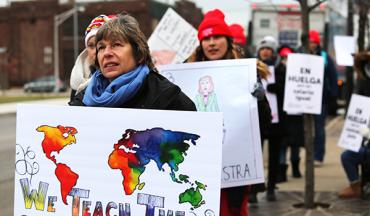Pickets, Protests and Progress
For American public education, 2018 was a turning point. At the year’s outset, Red for Ed was a hashtag; at the year’s end, it’s a movement. Americans’ frustration and apathy have turned into indignation and action over the fact that 25 states still spend less on K-12 public education than they did at the start of the 2008 recession. They have rejected Education Secretary Betsy DeVos’ attempts to defund, privatize and destabilize public schools. This was the year when the unlikely became possible in American education.
Tens of thousands of educators felt so demoralized and disrespected that they walked out of their classrooms to demand adequate resources for their students, higher wages and, in many cases, an end to massive tax cuts that decimate education funding. More than 80,000 people filled out report cards for DeVos (average grade: F) and used the “comments” section to describe the great things she would see at their public school if she deigned to visit.
After Marjory Stoneman Douglas (Florida), Great Mills (Maryland) and Santa Fe (Texas) high schools—among others—joined the somber roll of communities scarred by mass school shootings, young people said “no more.” Students from urban, rural and suburban communities organized the massive March for Our Lives this spring and the Student Gun Violence Summit this fall, where they drafted a Students’ Bill of Rights for Safer Communities to combat gun violence.
Unprecedented numbers of teachers ran for elected office. And voters supported pro-public education candidates and increases in education funding for preschool through higher education.
In many places and countless ways, educators and students proved that, by coming together, they could achieve what would be impossible for individuals on their own.
Teachers and school staff in all 55 counties in West Virginia, supported by their unions, parents and the broader community, built a statewide movement that won them investments in public education and raises for educators and other state employees.
Just as I picketed with our members in West Virginia, Oklahoma and Arizona during the first half of the year, last week I walked the strike lines with teachers and paraprofessionals in Chicago who waged—and won—the first-ever strike at a network of charter schools. They were fighting for, among other things, their immigrant students’ legal rights, as well as pay on par with their fellow Chicago Teachers Union members who work in traditional public schools, and whose support was key.
Yesterday, I joined thousands in Los Angeles who rallied for the public schools students deserve and against the scarcity they confront daily. The United Teachers of Los Angeles have worked tirelessly to convince officials to reduce testing and increase teaching, improve school safety, increase pay, and boost charter school oversight and accountability. The district claims poverty, but it has a nearly $2 billion “rainy day fund” that could be tapped to lower class size and provide all schools with at least one full-time nurse, counselor and librarian.
Inadequate resources for education have taken a toll, as have teachers’ lack of autonomy in their work and the lack of respect they feel. The annual PDK poll of attitudes toward public education found that, while most Americans have trust and confidence in teachers, for the first time a majority of parents would not want their child to become a teacher, with most citing poor pay and lack of respect. The 25 states that were funding public education below pre-recession levels at the beginning of 2018 are still shortchanging children and school staff. And while voters in many states elected pro-public education governors, in Florida, Gov.-elect Ron DeSantis, who won by less than 0.5 percent, has threatened to defund and privatize public schools.
Public schools are foundational to the United States. They must be safe, welcoming and joyful. They must help kids develop the knowledge, skills, and social and emotional strengths they need for successful lives. They create the basis for civic participation and pluralism in our country.
As the teacher walkouts made unmistakably clear, educators aspire to ensure all children have access to public schools like these. This will require schools to be adequately funded and educators to be paid professional wages they can live on. Rather than privatizing, defunding and destabilizing, let’s try this path for a change. My union is a committed partner in this work in communities from coast to coast.
As we look toward the New Year, let us draw our inspiration from those who find hope in darkness and who have made the unlikely possible—like the young people standing up against gun violence and the teachers speaking up for their students and their profession. We have seen throughout this year that, together, we can accomplish great things that would be impossible to accomplish alone. By engaging with communities around our shared aspirations, we can secure a voice at work and in our democracy and can forge a pathway to the better life that all families want and need.

